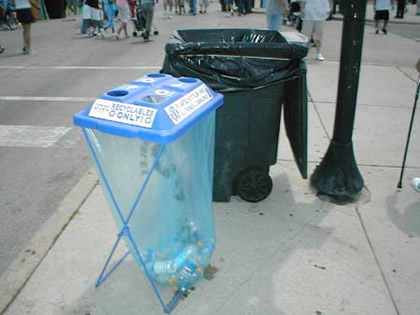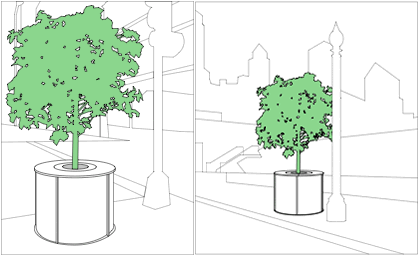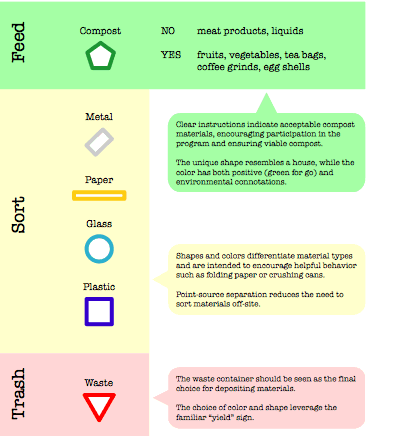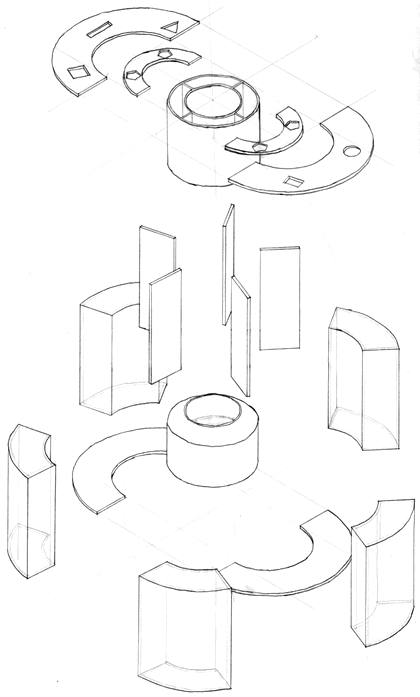
The current state of garbage and recycling collection. There has to be a better way.

Trees in situ.

A graphic language to encourage proper disposal of waste.

An exploded view of the complete assembly (minus the tree).

A cross-section of the complete assembly (minus the tree).
Feed the Tree is a new type of recycling receptacle designed to foster change within individuals, business, and industry.
The central focus of our design is a tree that literally uses waste as food.
In addition to a variety of socioeconomic and environmental benefits, our design makes visible the individual's role in the waste stream and ultimately suggests a future.
Design Intent Our design solution proposes an alternative to the current view of recycling as a point of success or failure revolving around the consumer. We seek to accomplish this goal with a two-pronged approach. One branch addresses the consumer’s role in a cyclical, beneficial system. The other branch pursues long-term, systemic change and reform within business and industry.
The physical design of our receptacle resembles a tree trunk, incorporating a ring of recycling containers and a ring of compost containers surrounding a living tree. This spatial arrangement reflects a temporal relationship between elements (transience to permanence) but has a practical purpose as well, providing ease of access when removing the recycling containers, ease of use when transferring compost to the tree, and utilizing the compost to insulate the tree in colder weather.
When using the receptacle, people are asked to sort their garbage into compost, recyclables, and waste, minimizing the need to sort the materials off-site. The receptacle uses unique, recognizable shapes and lettering to indicate different material types. Compost is stored close to the tree in four separate containers. Labels clearly indicate acceptable material for composting.
Individual, uniform containers store paper, plastic, metal, glass, and waste separately within the existing structure of the receptacle’s outer ring. The clear, plastic containers reveal the amounts and types of recyclables stored in the receptacles juxtaposed against the organic tree housed in their center. The uniform containers are interchangeable, reducing effort when emptying and replacing them.
The tree in our design shifts the focus of recycling from an act of sorting and throwing away to an act of care and attention. The tree is a long-term barometer: what does it mean or say about society if the tree dies? In return for supervision of its well-being, the tree cleans the air, acts as a carbon sink, promotes “social greening” through biophilia, and substantially reduces waste by removing compost material from the waste stream. The tree promotes awareness of the environment and healthier eating—healthier diets tend to produce more compostable material.
Compost provides a potential revenue source for the city, with the actual care and maintenance for individual trees managed under an “adoption” program. Initially, corporations or retailers might adopt trees as a way of offsetting side-effects of their business practices, but ultimately the tree’s purpose is to encourage social and business change. What is the role and responsibility of businesses who contribute to society’s waste problem? What are their waste products? What changes can they make to benefit us all?
In this way, the tree suggests a future. Consumers become involved in the beginning of a cycle, not simply the end of one. Their decisions have visible consequences, their actions relate to tangible, visible objects. The tree introduces an element of time beyond the immediacy of each transaction, a characteristic which we hope will translate into a greater appreciation for long-term thinking and ideally a practice of everyday consideration and appreciation for the world around us.